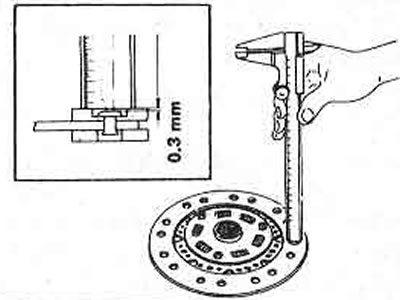Note: Due to the complexity of removing and installing clutch parts, it is generally considered good practice to replace the clutch friction disc, cover assembly and throwout bearing all at once, even if only one of these components is worn.
1. Remove the clutch assembly.
2. When cleaning clutch components, use a clean, dry cloth and work in a well-ventilated area.
3. Check the wear of the friction disc linings (Pic. 5.11), whether there is damage or oil contamination. If the distance from the surface of the linings to any of the rivets is less than 0.3 mm, if the linings are cracked, burned, or contaminated with oil or grease, the friction disc must be replaced.

Pic. 5.11. Using a caliper to measure the distance from the surface of the friction material to the rivets
4. If the pads are serviceable, check that the grooves in the center are not worn, the torsion springs are in good condition and securely attached, and all rivets are secure.
5. If the linings are contaminated with oil, it may be due to an oil leak from either the crankshaft seal or the transmission input shaft.
6. Check the support cover for obvious signs of wear or damage; shake it to check rivet installation or wear or damage to the clutch diaphragm spring support rings. If the spring is worn or damaged, the support cap must be replaced.
7. Check the condition of the working surface of the release bearing, disk and flywheel; they should be clean, flat and free of scratches or wear.
8. Check the release bearing as described in Chapter 14 of this Section.